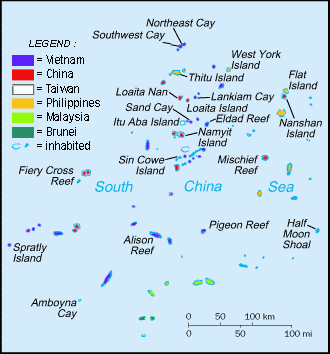Republic of Morac-Songhrati-Meads

The Republic of Morac-Songhrati-Meads is the fictional micronation in the Spratly Islands established by British naval captain James George Meads in 1877, according to the quixotic claims of a confidence man, Morton F. Meads.
Morton F. Meads
Morton Meads was a U.S. Army Soldier, discharged in Manila in 1946, for illegally engaging in various personal business ventures, mainly in the re-sale of army surplus.[1]
Meads' tale tales of his so-called birthright "Kingdom of Humanity" were captured in the local Philippine newspapers, which then caught the attention of the local Philippine military authorities. Meads was later arrested on criminal and civil charges for his business ventures, although these charges were later dropped. Regardless, Meads' fanciful storytelling sparked the motivation of powerful Filipino businessmen, such as Tomas Coloma, to race towards claiming the South China Sea Islands for the Philippines, such as the Spratlys.[2]
History
The republic's history begins with Morton Meads' supposed British forebear, Captain James George Meads, who laid claim to the Spratly Islands in 1877. Captain Meads was exploring the South China Sea on the Modeste and laid claim to the islands and took the name King James I.[3] Descendants of Meads have continued to posit legitimacy over the islands, and ownership of the islands' resources.[4][5]
Kingdom of Humanity

A rival entity called the "Kingdom of Humanity" formed in 1914[citation needed] under the leadership of Franklin M. Meads, the son of James George. The two rival factions continued their claim on the islands during World War II, when they were occupied by Japanese troops[citation needed]. Franklin died in 1945, and his son Josiah took over leadership [citation needed]; Josiah himself died soon after. His son, Morton F. Meads, was to succeed but was deemed too young.[6]
Legal attempts at legitimacy
The Kingdom faded into obscurity over the next decade until 1972[citation needed], when the then-ruling Morton Meads unsuccessfully petitioned the United Nations, Chiang Kai-shek of the Republic of China, and the Philippines to recognise the Kingdom and its claims.[6] Later that year, the remainder of the Kingdom's governing body drowned in a shipwreck off the coast of Philippines during Typhoon Ora, except for Meads.[3]
The Kingdom reappeared in 1985 [citation needed] when Meads sued the United States and others for $25 billion, claiming "unfair competition, harassment, [and] sabotage." The case was not heard.[7]
See also
References
- ^ Hubbert, E.B.; T.V. McIntyre (1971). Islands of South China Sea. Researach Study, Bureau of Intelligence & Research, Department of State (DOS). pp. 8–9.
- ^ Poling, Gregory (2022). On Dangerous Ground: America's Century in the South China Sea. Oxford University Press. pp. 56–57. ISBN 9780197633984.
- ^ a b Middleton, Nick (2015). An Atlas of Countries That Don't Exist: A Compendium of Fifty Unrecognized and Largely Unnoticed States. London: Macmillan. p. 186. ISBN 978-1-4472-9527-3.
- ^ Fowler, Michael; Julie Marie Bunck (1995). Law, Power, and the Sovereign State. Pennsylvania State University Press. pp. 54–55. ISBN 0-271-01470-9.
- ^ Whiting, Kenneth (2 February 1992). "Asian Nations Squabble Over Obscure String of Islands". Los Angeles Times. p. A2.
- ^ a b Samuels, Marwyn (1982). Contest for the South China Sea. pp. 169–71.
- ^ Miami Herald Staff (31 May 1992). "Atlantis And Other Wild Claims". Miami Herald. p. 11F.
Further reading
- Samuel Pyeatt Menefee, "Republics of the Reefs: Nation-Building on the Continental Shelf and in the World's Oceans", California Western International Law Journal, vol. 25, no. 1, Fall, 1994, pp. 83–85.
